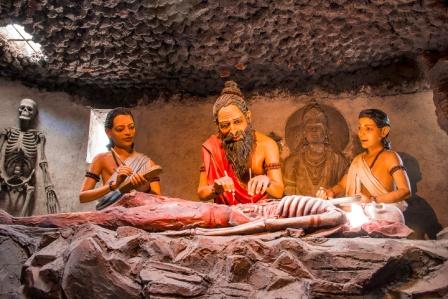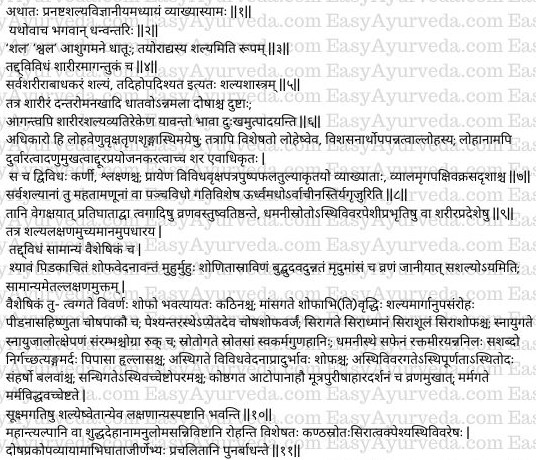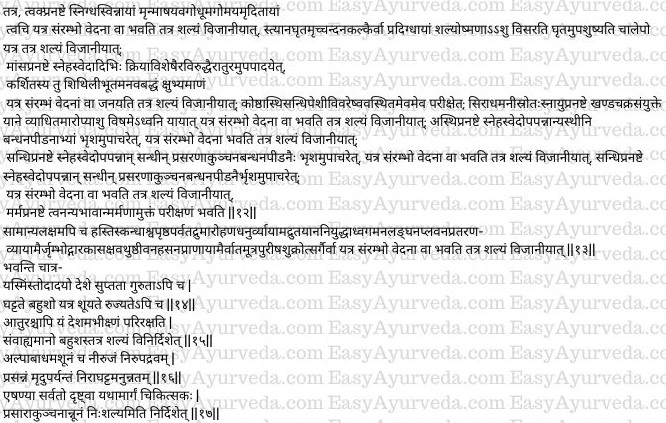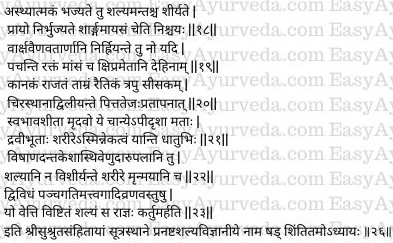Sushruta Samhita Chapter 26 Pranashta Shalya Vijnaniyamadhyaya
This article explains Sushruta Samhita Sutrasthana Chapter 26 “Pranashta Shalya Vijnaniyamadhyaya” – Knowledge of foreign bodies.

Table of Contents
Pranashta Shalya Vijnana

Knowledge of foreign bodies
We will expound the chapter by name Pranashta Shalya Vijnana- knowledge of foreign bodies lost (concealed) inside the body; as revealed by the venerable Dhanvantari.
Read – Lord Dhanwantari ‘The God of Ayurveda
Shalya nirukti
Etymology
The verbal roots “Sal” and “Sval” mean ‘moving quickly’; from the first root (sal) the term (Shalya) is derived.
Notes:- Dalhana, the commentator states that according to some authorities the root “Sval” means “causing misery or pain’ and the term “Shalya” is derived from it as that creates pain or trouble.
Shalya Bheda
Kinds of foreign bodies
It (shalya) is of two kinds viz. Sarira – bodily (derived from the body itself / internal) and Agantuka (coming from outside / external).
Shalya is that which produces trouble/ pain in the entire body. Since it (shalya) is described here (in this section / science), this science is known as “Shalya Sastra”(science of foreign bodies).
Saririka Shalya (derived from the body itself) are –
- the teeth, hairs, nails etc.
- vitiated Dhatus (tissues),
- waste products of food and
- aggravated Dosas,
Agantu Shalya (derived from outside) are those factors (substances and emotions) which are other than those (shalyas) of the body and which produce misery / pain.
Notes:- The term Dhatu includes even Upadhatus (secondary tissues) and Mala also includes Dhatumala (waste products of the tissues). Waste products of food are urine and faeces and waste products of tissues are sweat, ear wax, excretions of the eyes, nose and penis, pus, hairs, moustaches, eyelashes etc.
Read – Ashtanga Ayurveda – The Eight Branches of Ayurveda
Shalya Adhikara
Composition of foreign bodies
Shalya are composed / made from metals, bamboo, wood, grass, horns and bones of animals, especially from iron itself. Since it (iron) is used chiefly for slaughtering / to cause trouble (injury) the word shalya is most often used exclusively to describe the instruments or weapons made up of iron (or instruments and weapons made up of iron alone are often called as shalya).
Even among those which are made of iron, it is sara (arrow) alone that is meant here, because it is difficult to be pulled out, of having small mouth (orifice of entry into the body) and of being suitable for throwing (hurling) from a distance.
It is of two kinds-
- Karni- having an ear (ear like structure attached at its front) and
- Slakshana (smooth rod like without any attachments)
Generally, these are in the shape of leaves, flowers and fruits of different kinds of trees or the face (mouth) of wild animals and birds.
Read – Sushruta’s 8 Types Of Surgical Procedures – Astavidha Shastra Karma
Shalyagati
Direction of movement of foreign bodies
Direction of movements of all kinds of foreign bodies (especially the arrow), whether big or minute, are only five, such as;
- upward,
- downward,
- backward,
- sideward and
- straight
Notes:- According to Dalhana upward means from below upward, downward means from above downwards, backwards means from back to front, sideward means obliquely and straight means from front to back.
Shalya Asraya
Dwelling of foreign bodies
These (foreign bodies, especially the arrow) because of diminished force or because of obstruction, get lodged in the skin and other medium of wounds (tissues which are the seats of wounds); or in arteries, channels, hollow of bones, muscles or other places of the body.
Read – Foreign Body Removal – Ashtanga Hrudaya Sutrasthana 28
Shalyaja Laksana
Symptoms produced by foreign bodies
Next, listen carefully, to the symptoms produced by the foreign bodies which are being described now. These (symptoms) are of two kinds, viz Samanya (general / common) and Vaisesika (special).
Samanya (general) – when the wound is associated with the below mentioned features it should be understood as having a foreign body inside it. Here, the wound –
- is blue (blackish blue)
- is studded with eruptions
- has swelling and pain
- exudes blood frequently
- is bulged up like a bubble
- the muscles are soft
These are the common/ general symptoms.
Vaisesika (special) – special symptoms are the following –
- When the shalya is lodged in the skin there is change in the colour of the skin and swelling is found broad and hard.
- When the shalya is the muscles, there is increase of swelling, appearance of new growth in the path of the foreign body, inability to tolerate pressing (tenderness), sucking pain and suppuration (formation of pus).
- When it is inside muscle sheaths, the same symptoms are found except sucking pain and swelling.
- When it is the veins, there is distension of the vein, pain and swelling of the veins.
- When it is the Snayu (ligaments) there is shaking of the network of ligaments, profound swelling and pain.
- When lodged in the Dhamani (artery) vata gets aggravated and causes flow of frothy blood associated with sound, and is associated with pain all over the body, thirst and nausea.
- When lodged in the bone, there is manifestation of various kinds of pains and swelling.
- When it is lodged in the cavity of bones, it would cause filling of the cavity of bones, pricking pain in the bones and strong / severe form of restlessness or severe rubbing or friction.
- When it is lodged in the bony joints it would cause symptoms similar to the foreign body lodged in the bones along with loss of functions of those joints.
- When it is lodged in the alimentary canal there is gurgling noise, flatulence, (appearance of) flow of urine, faeces and food particles from the orifice (opening) of the wound.
- When it is in the vital spots, symptoms of injury of that spot appear when actions (movements) are done.
- In case of minute foreign bodies lodged in the body, the same symptoms will be present but slightly (not well manifest).
Curable wounds with foreign bodies in them
Foreign bodies either big or small, when present in persons whose body is pure (un-vitiated by aggravations of dosas) and when it has stayed (or entered) in the directions of the hair (from above downward) then it (the wound) gets healed, especially those present in the passage of the throat, veins, skin, muscles and cavity of the bones. The foreign body which gets dislodged from its place due to aggravation of the Doshas, exercise, injury and indigestion produce troubles in the body again.
Read – Injury, Wound care Ayurvedic Remedies, Medicines
Shalyasthanaa Jnanodaya

- Determining the site of foreign body
- When the foreign body is lost / concealed in the skin, the body should be anointed with oils and fomented. Then a paste of mud, flour of Masa, Yava, Godhuma or cow dung is (either in combination or together) is applied and rubbed on the skin. The site wherein swelling, redness and pain developed due to rubbing of these medicaments should be considered as the site of lodgement of the foreign body.
- Similarly, when a lump of solid ghee or paste of mud or Candana (sandalwood) is applied on the body, the place where the ghee melts and spreads of and the paste (of mud and sandalwood) dries up quickly by the heat of the foreign body (heat produced in that site due to the presence and lodgement of a foreign body) is to be understood as the site of lodging.
- When the foreign body is lost / concealed in the muscles, the patient should be administered oleation, sudation and other therapies which are not harmful or mutually contradictory. In emaciated individuals the place or site wherein the foreign body which has become loosened, non-sticking i.e., displaced from its site and gets agitated and gives rise to redness and swelling or pain should be considered to be having the foreign body (site of presence of foreign body).
- When it is lodged in the alimentary tract, bony joints, vacant spaces in the muscles and bone, the place should be determined by these (above) methods only.
- When the foreign body has been concealed (lodged) in sira (veins), dhamani (arteries), srotas (channels and passages) and snayu (ligaments), he or she should be made to sit on a cart, the wheel of which is broken and the cart be made to run on an irregular road. The place of the body which develops swelling and pain should be considered to be having a foreign body concealed inside it.
- When the foreign body is lost / concealed in the bone, the patient should be given oleation (anointing) and fomentation (sudation) and then the bones should be tied with bandages tightly or squeezed hard. The place where redness, swelling or pain develops should be determined as the site of the foreign body (place where the foreign body is concealed).
- When the foreign body is concealed in the bony joints of the body, the joints should be administered with oleation and sudation first. Then flexion, extension, bandaging and pressure / pressing etc should be done on these joints. The place in which swelling and pain develops should be considered to be having shalya i.e., foreign body concealed in it.
- When the foreign body is concealed in the vital spots, since these are not other than (apart from) the tissues, the same methods described so far have been adopted for determination of the site of foreign bodies.
Read – Marma Shaareera: Definition, Composition: Vital Points of The Body
Common methods to determine the site of the foreign body
Common methods of determining the site of the foreign body are as explained below. The place where swelling or pain develop during the below mentioned activities should be understood as the site of the foreign body (place of the body where the foreign body is concealed) –
- riding on an elephant or a horse
- climbing a hill or a tree
- bending a bow
- exercise
- walking fast
- wrestling
- walking long distance
- long jumping / high jumping
- swimming
- jumping high
- yawning
- belching
- coughing
- sneezing
- spitting
- laughing
- controlling breathing
- eliminating of flatus, urine, faeces or semen
The place of the body wherein pricking and other types of pain appears, and where numbness / absence of sensation and feeling of heaviness are present, the place wherein discharges and pricking pain occurs when rubbed or scratched, the place of the body which the patient himself protects excessively and constantly, and the place of the body which the patient presses constantly should be understood as the site of the foreign body (wherein the foreign body is concealed).
Nisshalya Sthana

Place free from foreign body
The physician shall consider (declare) any place free of foreign body (foreign body has been removed or expelled) when the below mentioned features are present –
- the place having mild troubles,
- the place having no swelling, no pain, no complications,
- the place is clean (without change of colour) and soft all around,
- the place is static (without any unusual movements),
- the place is not elevated,
- the place is searchable thoroughly by probing in all sides through the passage of entry,
- not having any difficulty for extension and contraction (and other movements also)
Read – Yantra Instruments used in Ayurveda: Ashtanga Hrudayam Sutrasthana 25
Shalya gati
Fate of foreign bodies inside
- Foreign bodies which consist of bone get broken inside the body or split into small pieces; those of horns of animals and iron get bent without doubt.
- Those of wood, bamboo and grasses, when not pulled out quickly, will cause suppuration (pus formation) of blood and muscles.
- Those made of gold, silver, copper, brass, tin and lead, when staying for long in the body, get dissolved (and absorbed) in the same place by the heat of pitta.
- Those which are cold and soft by nature and such other qualities get liquefied inside the body and become one (fused) with the tissues.
- Those foreign bodies, such as horn, teeth, hair, bone, bamboo, wood, stone and mud do not get destroyed inside the body.
- The physician who understands the two kinds and five directions (of entry of the foreign bodies) and the symptoms these produce in the skin and other seats of wounds, will only be entitled to treat the king.
Thus ends the Twenty-sixth chapter by Name Prasanta Shalya Vijnaniya in Sutra Sthana of Susrutha Samhita.









